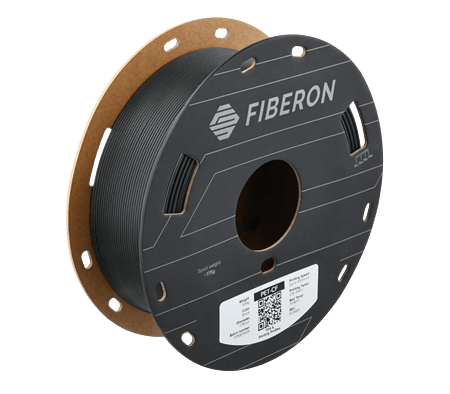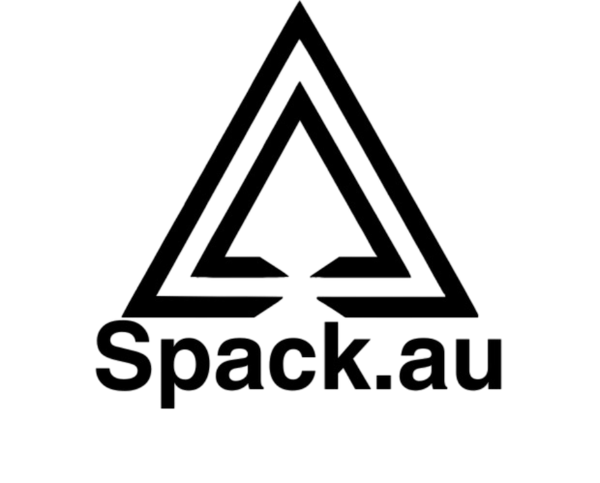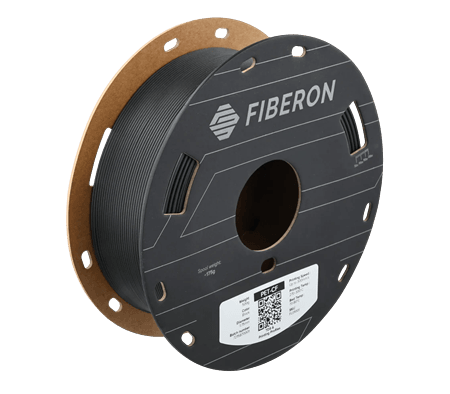Polymaker
Fiberon PET-CF17 500g 1.75mm Filament by Polymaker
Fiberon PET-CF17 500g 1.75mm Filament by Polymaker
Low stock: 1 left
Couldn't load pickup availability
High quality and high performance Fiberon PET-CF17 by Polymaker.
- High performance PET-CF with 17% carbon fiber reinforcement.
- High bending modulus and tensile strength.
- High heat resistance up to 147℃ HDT after annealing.
- Low moisture sensitivity for humidity or wet applications.
- Cost-effective and high speed capable.
- Fantastic dimensional stability.
- Reliable and consistent tolerance (1.75mm diameter +/- 0.03mm)

Fiberon PET-CF17 is a brand new high-speed composite 3D printing material developed by Polymaker to deliver strength and performance without moisture sensitivity concerns. Fiberon PET-CF17 carbon fiber reinforced filament excels at rapid prototyping, offering exceptional print quality and dimensional accuracy. Combining the best of strength, speed, and surface finish into one versatile composite filament.
Features
- Excellent stiffness & moisture insensitivity - Compounded with 17% chopped carbon fiber, Fiberon PET-CF17 delivers excellent mechanical strength and stiffness for a wide range of jig, fixture, automotive and manufacturing applications. Fiberon PET-CF17 is a "moisture insensitive" composite filament[1] , ensuring excellent mechanical properties regardless of moisture absorption. This is in comparison to parts produced in nylon-based carbon fiber that absorb moisture from the air, a process which reduces tensile strength and stiffness of carbon fiber nylon parts. With Fiberon PET-CF17, users can print end-use parts for a wide range of industries without concerns of mechanical performance if the component is exposed to humid or wet applications.
- High Heat Resistance - Featuring a heat deflection temperature of up to 147°C after annealing[2], Fiberon PET-CF17 heat resistance delivers an easy-to-use composite material for a wide range of end-use applications.
- High Speed Capable - Fiberon PET-CF17 has been developed with printer compatibility in mind and is high speed capable, enabling printing up to 300mm/s on suitable high speed printers.
- Dimensional Accuracy & Excellent Surface Finish - Carbon fiber reinforcement in Fiberon PET-CF17 delivers an outstanding surface finish with fantastic dimensional accuracy and low shrinkage during printing.
[1] Moisture insensitivity does not describe whether the filament should be kept dry for optimal print quality. This description of moisture insensitivity is in the context of the end-use application where extremely moisture sensitive materials like PA6-CF see a significant reduction in mechanical properties as the part absorbs moisture. With PET-CF moisture absorption is minimal and doesn't impact the mechanical properties of the part. For best printing results PET-CF17 should still be kept dry during printing and storage.
[2] Fiberon™ PET-CF17 displays the best mechanical and thermal properties when fully crystallized. The printed part will not reach full crystallisation during the printing process, an additional step is required: Annealing. PET-CF17 can be annealed in the oven at 120˚C for 10 hours. Please see settings & specifications tab for detailed annealing instructions.
Technical Data

All PET-CF specimens were printed with 300°C nozzle temperature, 70°C bed temperature, cooling fan OFF and samples were annealed after printing at 120°C for 10h. Samples were printed with 100% infil, 2 shells and 3 top & bottom layers.
FIBERON PET-CF 17 THERMAL PROPERTIES
| Value | Testing Method | |
| Glass Transition | 79.3°C | DSC, 10°C/min |
| Heat Deflection Temperature |
0.45MPa - 147.5°C HDT Curve |
ISO 75 |
| Vicat Softening Temperature | 238.4°C | ISO 306, GB/T 1633 |
FIBERON PET-CF 17 MECHANICAL PROPERTIES
| Value | Testing Method | |
| Youngs Modulus (X-Y) |
5481.0 ± 223.7 MPa | ISO 527, GB/T 1040 |
| Youngs Modulus (Z) |
3558.8 ± 260.4 MPa | |
| Tensile Strength (X-Y) |
65.9 ± 1.0 MPa | ISO 527, GB/T 1040 |
| Tensile Strength (Z) |
27.9 ± 1.3 MPa | |
| Bending Strength (X-Y) |
109.3 ± 2.0 MPa | ISO 306, GB/T 1633 |
| Bending Strength (Z) |
43.4 ± 8.8 MPa | |
| Charpy Impact Strength Notched (X-Y) |
5.1 ± 0.2 kJ/m2 | ISO 179, GB/T 9343 |

Data taken from Polymakers Technical Data Sheet and is intended for reference and comparison purposes only. Due to the nature of 3D printing, data should not be used for design specifications or quality control purposes.
Printing Settings
| Nozzle Temperature | 270°C - 300°C |
|---|---|
| Build Plate Temperature | 70°C - 80°C |
| Enclosure | Recommended |
| Chamber Temperature | Room temperature is suitable. |
| Cooling Fan | OFF for better strength |
| Printing Speed | Up to 300mm/s |
| Retraction | The ideal retraction settings vary from printer to printer and depend on the hot end. The following settings have been a good starting point for many machines. Direct Drive: Retraction distance of 3mm with retraction speed of 40mm/s Bowden: Retraction distance of 6mm with retraction speed of 60mm/s |
| Recommended Support Material |
PET-CF17 is compatible with PolySupport for PA12 |
The above are printing recommendations based on 0.4 mm nozzle. Please note ideal printing conditions may vary depending on your 3D printer setup. For high speed 3D printers, make sure to use a suitable printer and increase your extrusion temperature in order to use higher printing speeds.
Hardened nozzles such as hardened steel are less conductive than brass, so depending on your 3D printer, printing with a higher extrusion temperature may be required when using a wear resistant nozzle.
We highly recommend to use a wear resistant nozzle when printing Fiberon™ PET-CF17. Hardened steel offers much better wear resistance than brass. The second consideration it to keep PET-CF dry during printing and storage. See "Storage and Drying" details below for instructions to protect Fiberon™ PET-CF17.
Specific Printing Tips for Fiberon™ PET-CF17.
- Fiberon™ PET-CF17 is a very stiff filament due to its carbon fiber reinforcement. When not in use, please use tape to secure the filament tip to the spool the rather than attempting to bend the filament through the spool guide hole. During printing it is required to have a smooth feeding path to ensure optimal feeding. For example we recommend avoiding excessive bending in the filament guide system.
- Fiberon™ PET-CF17 can easily damage a brass nozzle after a few hundred grams of printing. Nozzles come in many different materials from soft to hard and the heat conductivity of a nozzle can change depending on what material it is made of. Hardened steel is more abrasion resistance than brass or a nickel plated nozzle.
- Inter-layer strength can depend significantly on your extrusion temperature which is a result of your printing speed, nozzle type and hot end. A higher nozzle temperature / extrusion temperature can offer significant benefits in regards to inter-layer strength. When printing Fiberon™ PET-CF17 at low temperature (270 ˚C) on a general desktop 3d printer, it is recommended to use a hardened nickel-coated brass nozzle which offers better thermal conductivity than hardened steel or a high flow hot-end to ensure better melt performance.
Annealing PET-CF17
For the best mechanical performance it is highly recommended to anneal parts printed in Fiberon™ PET-CF17. Annealing is the process of heating up the printed parts at a certain temperature for a certain period of time. Fiberon™ PET-CF17 displays outstanding mechanical and thermal properties when fully crystallised. The printed part will not reach full crystallisation after the printing process and annealing is required to complete this step.
We strongly recommend 120°C, 10h annealing to achieve the best performance of the material. To avoid deformation of the prints during annealing, please pay attention to the following:
1. Before returning the prints, please confirm that the prints have been printed for more than 24h, or placed in an 80-degree oven for 2h to eliminate the internal
stress after printing.
2. During annealing, do not touch the sample with your hands or apply any additional load to the sample.
3. During annealing, ensure that the temperature in the oven is uniform and there are no obvious obstructions that cause uneven temperature of the sample.
4. For prints with a bridge length of more than 3cm, or a thick layer on the upper part of the bridge; prints with large overhangs or small overhangs; all need to add
supports and anneal in the oven together with the supports.
5. For thin-walled areas with a wall thickness of less than 4mm, you can try to add reinforcing ribs or increase the wall thickness to avoid possible annealing
deformation.
6. In principle, the sample placement method needs to be consistent with that during printing, and it is best to enter the oven directly together with the base plate.
Specification
| Net Weight | 500g |
|---|---|
| Material Type | PET with 17% chopped carbon fiber by weight. |
| Density | 1.34 (g/cm3 at 21.5˚C) |
| Equilibrium Water Absorption (70% RH, 23°C) |
0.53% |
| Colour |
Black |
Compatibility
Fiberon™ PET-CF17 has been engineered so users can print strong carbon fiber filled parts on a wide range of 3D printers. As the carbon fiber in this material is highly abrasive we recommend customers first check that their 3D printer is equipped to print abrasive materials before purchasing this product.
Aside from wear resistance, there are a few important considerations for this material that we recommend.
To get the best mechanical and thermal properties out of this material, annealing is strictly recommended. Please read information further above regarding annealing steps.
Reinforced filaments tend to be much stiffer than other standard filaments and this can cause problems when passing the filament through a printer’s feeding system. For a steady and uninterrupted flow of filament, it is recommended to take extra care and make sure your filament guide system is smooth and with minimal bends. Brass nozzles give a better thermal conductivity than hardened nozzles such as stainless steel. Depending on your 3D printer, printing with higher extrusion temperatures may be required when using specialty nozzles to ensure the correct extrusion temperature is achieved.
Of course with thousands of unique 3d printer models on the market, we can't guarantee each filament type will work with every 3D printer. Slicer experience and setting adjustment is always required to get the most out of a material. Before jumping into an ambitious project we always recommend printing some known calibration tests to build or make adjustments to the filament profile.
Technical Data & Safety Data Documents
We have full MDS and technical data sheets for Fiberon™ PET-CF17 and all other Fiberon filaments from Polymaker. Contact us to enquire!
The typical values presented in Polymakers data sheet are intended for reference and comparison purposes only. Due to the nature of 3D printing they should not be used for design specifications or quality control purposes.
STORAGE & DRYING
All plastics are hygroscopic meaning they absorb moisture from the air which can affect printing quality and strength of printed parts. How quickly this absorption occurs depends on the material and your environment. Fiberon™ PET-CF17 filaments are dried and packaged in a vacuum sealed bag with desiccant to ensure the best printing quality. When not in use Fiberon™ PET-CF17 should be stored away from sunlight and sealed in the packaged resealable bag.
Although filaments can be dried, drying will speed up the aging process of the plastic. Preventing the filament from absorbing moisture in the first place is the best solution to keep your filament working to its maximum potential. For long term storage we highly recommend storing in a sealed container with dry desiccant that reduces the relative humidity to 10-20% RH.
In-house we manage our fialments with Polymakers PolyDryer™ which keep offers best-in-class sealing to protect filaments from absorbing moisture
If you hear popping sounds and notice that the surface quality of your print is uneven or the colour is not consistent, this is a likely indicator that the filament has absorbed too much moisture. Spools of Fiberon™ PET-CF17 can be dried with Polymaker PolyDryer™ using power level 3 for 18 hours.. Alternatively if you have a convection oven that is accurate at low temperatures, users can dry filament in a preheated convection oven at 100˚C for up to 10 hours. Results may vary depending on the accuracy of your oven so please be conservative. For more information about filament drying please read our user guide.
FAQ
Q: What is PET? Is it like PETG?
A: PET (Polyethylene terephthalate) is one of the most common thermoplastic materials and a material that you would encounter quite often in the real world. PET is commonly used to make plastic water bottles, fibers in clothing and is combined with composite fibers for engineering applications. It should not be confused with PETG however it is in the same polyester family as materials like PETG (Polyethylene Terephthalate Glycol) and PCTG (Polycyclohexylene dimethylene terephthalate). PET is a semi-crystalline polymer that can be annealed to achieve high heat resistance beyond its glass transition temperature. This an important comparison to PETG which is an amorphous material that cannot be annealed to improve heat resistance beyond its glass transition temperature.
Q: Do I need to anneal PET-CF?
A: In short, yes you should anneal parts printed in PET-CF. The thermal and mechanical properties are directly tied to its crystallisation, a process in which the polymer chain aligns to create tightly packed regions that improve heat resistance and strength. Annealing is an important step to complete the crystalline process and ensure consistency and high performance. Skipping the annealing process means the part hasn't been produced correctly.
Q: Do I need an enclosure to print PET-CF?
A: This is really dependent on the ambient room temperature, size, geometry and infil density of your parts. The general rule of thumb is that the larger your project is, the more important an enclosure or heated chamber becomes. When printing without an enclosure it is important to keep the printer away from cold drafts that could impact the print.
Q: Should I rewind this filament if I want to use it with a different spool?
A: We strongly advise against tampering with the product by rewinding. See our article for full details about the risks. All Polymaker filaments are wound with tension but without strain. Rewinding completely rearranges the curvature of the winding and this strain over time can cause most plastics to catastrophically break. If for some reason your printer is locked into fitting less than standard sized spools, there may be safe printable adaptors or external mounting solutions available.
Don't know where to start? Or which filament will suit your application? We have a broad range of support options including telephone support. Contact us today!
| Filament | |
| Diameter | 1.75mm |
| Spool Weight | 500g |
Materials
Materials
PLA - This solid filament is used to make models that are a refined representation with rigid properties.
TPU - This flexible filament holds the shape of the model and can with stand being twisted and squashed to survive the field environment.
Shipping
Shipping
Free standard shipping and Express for free orders over $300 calculated at the checkout.
All items are shipped from Townsville, QLD.
Shipping World Wide - coming soon.
Care Instructions
Care Instructions
PLA
Temperature:
Keep it cool! PLA starts to soften at around 60°C (140°F), so avoid placing it near heat sources or leaving it in hot cars.
Sunlight:
Prolonged direct sunlight can cause fading and potential deformation. Try to keep it out of long sun exposures.
Cleaning:
Gently wash with warm water and a bit of mild soap using a soft cloth. No harsh scrubbing, please!
Handling:
Handle with care—avoid excessive bending or dropping it, as PLA is rigid and can crack or break.
Storage:
Store in a cool, dry place to maintain its shape and longevity.
TPU
Temperature:
TPU is built to be flexible, but still avoid extreme or prolonged heat. It’s more resilient than PLA, but unnecessary heat can still degrade it over time.
Sunlight:
Try not to leave TPU items in direct sunlight for too long, as UV rays can fade the colors and slowly affect the material quality.
Cleaning:
Just like PLA, a quick clean with warm water and mild soap works great. Use a soft cloth and don’t be too rough.
Handling:
Enjoy its flexibility! However, even though TPU can bend, continuous stretching or heavy impacts might wear it out faster.
Storage:
Keep it in a cool, dry spot away from harsh elements to maintain its flexibility and appearance.
Share


